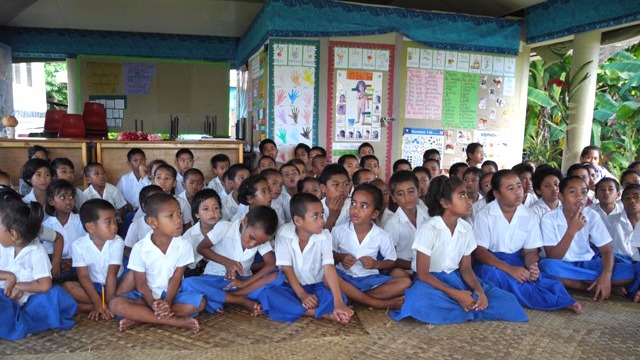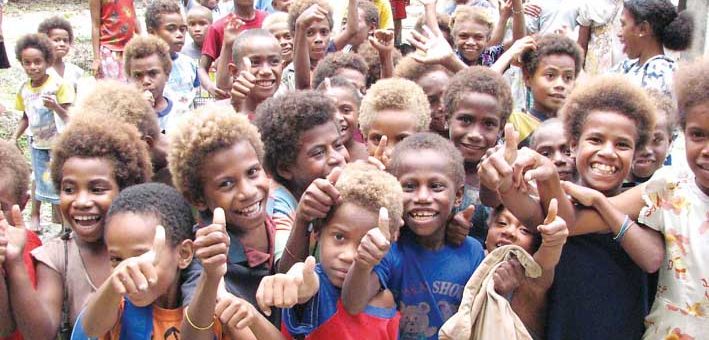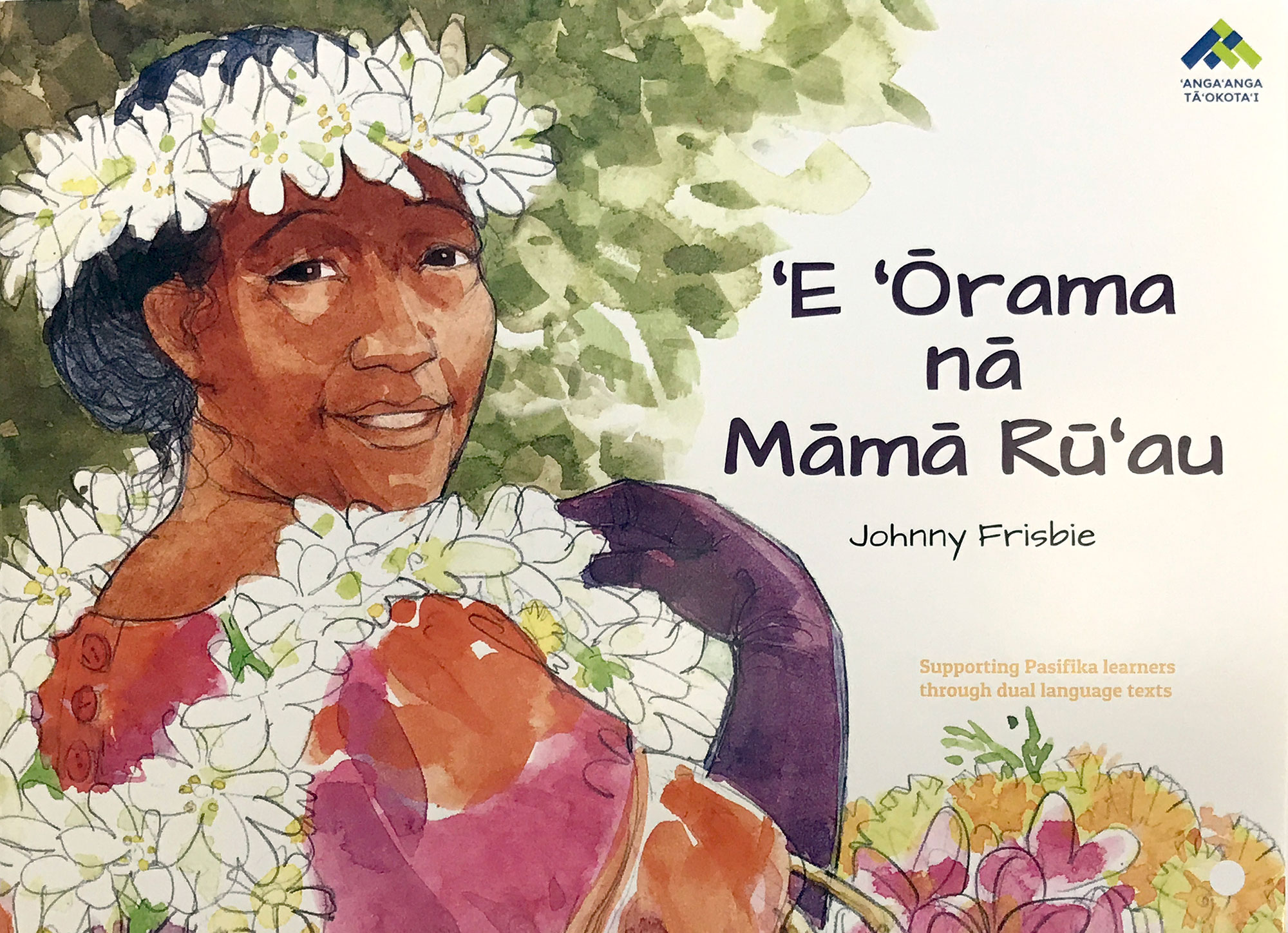Most stories for New Zealand children are published in English and some in te reo Māori – but what if you want to read a story with your child in a Pasifika language? For decades Don Long has published educational works in Pasifika languages, editing in reo Māori Kūki ‘Airani, vagahau Niue, gagana Sāmoa, gagana Tokelau, lea faka-Tonga, and English. He tells us what’s out there now.

Besides a couple of classics translated into Samoan by Huia Publishers – ‘O le Ketapila Matua Fia ‘Ai (The Very Hungry Caterpillar) and ‘O le Nofoaga ‘olo ‘o iai Meaola Uiga‘ese (Where the Wild Things Are) – commercial publishing of Pasifika children’s stories in Pasifika languages is pretty thin on the ground. Most Pasifika language stories are published for the education market – and almost always, these resources are published by ministries of education. There are occasional exceptions, but sadly, they are rarely long-lasting.
Momoe von Reiche’s Madd Gallery in Apia, for example, has produced children’s books in Samoan through its Niu Leaf imprint – and may yet do so again. And the Institute of Education at The University of the South Pacific in Suva has published some wonderful picture books in Fijian through its Waka Books imprint, and has started to add picture books in Tongan through its Tonga campus – in addition to the many educational readers in Pasifika languages that the Institute has published over the years.
But these are just drops in the Pasifika ocean.
The books produced for the education market are sometimes beautifully produced. They can look much like commercial picture books, but you won’t find them in bookshops or public libraries – you’ll find them in schools. For example, Lift Education is currently developing books in five Pasifika languages (and English) – including in six dialects of Cook Islands Māori – variously for the ministries of education in the Cook Islands, New Zealand, the Solomon Islands, and Tonga.

A closer look at one of these projects offers a glimpse into the fascinating world of publishing in Pasifika languages, which people who don’t work in schools so rarely see.
The New Zealand Ministry of Education is currently publishing books for young children in five Pasifika languages and English through its ‘Supporting Pasifika Learners through Dual Language Texts’ initiative. These books are published in reo Māori Kūki ‘Airani, vagahau Niue, gagana Sāmoa, gagana Tokelau, lea faka-Tonga, and English.
Ninety-nine of these books are already available to New Zealand schools, with another 24 currently in production. They are aimed at bilingual children in their first year of primary school, to bridge them into reading English-medium books. As well as the books, there are associated resources for families and teachers, plus audio support in all six languages.
This wealth of Pasifika story-telling supports families and junior class teachers to build on all the early literacy experiences and skills that bilingual Pasifika children bring to the classroom, rather than only on the experiences and skills they have in English. Many of these skills are easily transferred back and forth between Pasifika languages and English.
So, who wrote these books, who illustrated them, and what are they like?
The authors of these books include Sarona Aiono-Iosefa, Tusiata Avia, Vaitoa Baker, Christine Finau, Dan Taulapapa McMullin, Carmen Scanlan-Toti, Ma‘ara Taia Scheel, Tiva Toeono, Feana Tu‘akoi, and Edgar Tu‘inukuafe, to name but a few. The illustrators include well-known artists, such as Jennifer Lautusi and Gus Sinaumea Hunter (who works for Weta Workshop and whose artwork can also be seen in The Lord of the Rings and The Hobbit, among many other films).

To look at one of these books in more detail, in ‘E ‘Ōrama nā Māmā Rū‘au (Granny’s Wish), the Pukapukan writer Johnny Frisbie takes us into the world of three young girls in New Zealand during a visit from their Cook Islands grandma. (When Johnny wrote the story, she had granddaughters living in Dunedin.) Granny tells the girls stories about Pukapuka, and offers to be the flower girl when one of her grand-daughters gets married. The wonderfully colourful illustrations are by Judith Kunzlé, who was based in Avarua when she drew them. Johnny Frisbie became the first Pasifika woman to become a published author when she was published in New York by Macmillan in 1948 and Doubleday in 1959. She wrote her first book in Pukapukan, Samoan, and English when she was still a teenager. She remains one of the most widely published Pasifika children’s authors. Lately, she has published a whole series of linked stories in The School Magazine, which is published by the New South Wales Department of Education.
Overall, this New Zealand Ministry of Education series of books is rich in Pasifika stories – in language, life, and culture. And, while you won’t find these books or many other examples of Pasifika language children’s books in bookshops and public libraries, if you have a child attending a primary school in New Zealand or elsewhere in the Pacific, then it’s quite a different story.

Don Long
Don Long is a Wellington-based author and editor. The New Zealand Māori-language version of his picture book, The Battlefield, won LIANZA’s Te Kura Pounamu award in 2004 and a story set in the world of a Tlingit boy growing up in the Pacific Northwest recently won a UNESCO award for multicultural stories for young people. Don was, for 20 years, an editor of Māori and Pasifika resources at Learning Media, where he founded the Tupuseries and Fōlauga. He currently works at Lift Education, where he is editing the dual-language series of books for the Ministry of Education in five Pasifika languages mentioned in this article. He has also recently edited A River of Stories, the Commonwealth Education Trust’s publication of a four-volume anthology of writing for young people from the 52 countries of the Commonwealth.



